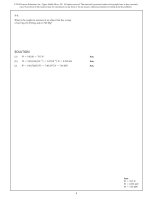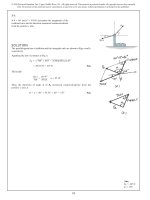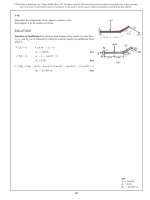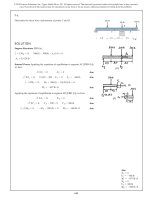Dynamics 14th edition by r c hibbeler section 14 1 14 3
Bạn đang xem bản rút gọn của tài liệu. Xem và tải ngay bản đầy đủ của tài liệu tại đây (1.44 MB, 27 trang )
THE WORK OF A FORCE, THE PRINCIPLE OF
WORK AND ENERGY & SYSTEMS OF PARTICLES
Today’s Objectives:
Students will be able to:
1. Calculate the work of a force.
2. Apply the principle of work and
energy to a particle or system of
particles.
Dynamics, Fourteenth Edition
R.C. Hibbeler
In-Class Activities:
• Check Homework
• Reading Quiz
• Applications
• Work of a Force
• Principle of Work and
Energy
• Concept Quiz
• Group Problem Solving
• Attention Quiz
Copyright ©2016 by Pearson Education, Inc.
All rights reserved.
READING QUIZ
F
1. What is the work done by the force F?
A) F s
B) –F s
C)
D) None of the above.
Zero
s1
s2
s
2. If a particle is moved from 1 to 2, the work done on the
particle by the force, FR will be
A)
B)
C)
D)
Dynamics, Fourteenth Edition
R.C. Hibbeler
Copyright ©2016 by Pearson Education, Inc.
All rights reserved.
APPLICATIONS
A roller coaster makes use of gravitational forces to assist the
cars in reaching high speeds in the “valleys” of the track.
How can we design the track (e.g., the height, h, and the radius
of curvature, ) to control the forces experienced by the
passengers?
Dynamics, Fourteenth Edition
R.C. Hibbeler
Copyright ©2016 by Pearson Education, Inc.
All rights reserved.
APPLICATIONS (continued)
Crash barrels are often used
along roadways in front of
barriers for crash protection.
The barrels absorb the car’s
kinetic energy by deforming.
If we know the velocity of
an oncoming car and the
amount of energy that can
be absorbed by each barrel,
how can we design a crash
cushion?
Dynamics, Fourteenth Edition
R.C. Hibbeler
Copyright ©2016 by Pearson Education, Inc.
All rights reserved.
WORK AND ENERGY
Another equation for working kinetics problems involving
particles can be derived by integrating the equation of motion
(F = ma) with respect to displacement.
By substituting at = v (dv/ds) into
Ft = mat, the result is integrated to
yield an equation known as the
principle of work and energy.
This principle is useful for solving problems that involve
force, velocity, and displacement. It can also be used to
explore the concept of power.
To use this principle, we must first understand how to
calculate the work of a force.
Dynamics, Fourteenth Edition
R.C. Hibbeler
Copyright ©2016 by Pearson Education, Inc.
All rights reserved.
WORK OF A FORCE (Section 14.1)
A force does work on a particle when the particle undergoes a
displacement along the line of action of the force.
Work is defined as the product of force
and displacement components acting in
the same direction. So, if the angle
between the force and displacement
vector is , the increment of work dU
done by the force is
dU = F ds cos
By using the definition of the dot product
and integrating, the total work can be U =
1-2
written as
Dynamics, Fourteenth Edition
R.C. Hibbeler
r2
F • dr
r1
Copyright ©2016 by Pearson Education, Inc.
All rights reserved.
WORK OF A FORCE (continued)
If F is a function of position (a common
case) this becomes
s2
U1-2 F cos ds
s1
If both F and are constant (F = Fc), this equation further
simplifies to
U1-2 = Fc cos s2 - s1)
Work is positive if the force and the movement are in the
same direction. If they are opposing, then the work is
negative. If the force and the displacement directions are
perpendicular, the work is zero.
Dynamics, Fourteenth Edition
R.C. Hibbeler
Copyright ©2016 by Pearson Education, Inc.
All rights reserved.
WORK OF A WEIGHT
The work done by the gravitational force acting on a particle
(or weight of an object) can be calculated by using
y2
U1-2 =
- W dy
y1
U1-2 = - W (y2 − y1) = - W y
The work of a weight is the product of the magnitude of
the particle’s weight and its vertical displacement. If y
is upward, the work is negative since the weight force
always acts downward.
Dynamics, Fourteenth Edition
R.C. Hibbeler
Copyright ©2016 by Pearson Education, Inc.
All rights reserved.
WORK OF A SPRING FORCE
When stretched, a linear elastic spring
develops a force of magnitude Fs = ks, where
k is the spring stiffness and s is the
displacement from the unstretched position.
The work of the spring force moving from position s1 to position
s2
s2
s2 is
U1-2 Fs ds k s ds = 0.5 k (s2)2 – 0.5 k (s1)2
s1
s1
If a particle is attached to the spring, the force F s exerted on the
particle is opposite to that exerted on the spring. Thus, the work
done on the particle by the spring force will be negative or
U1-2 = – [ 0.5 k (s2)2 – 0.5 k (s1)2 ].
Dynamics, Fourteenth Edition
R.C. Hibbeler
Copyright ©2016 by Pearson Education, Inc.
All rights reserved.
SPRING FORCES
It is important to note the following about spring forces.
1. The equations above are for linear springs only! Recall
that a linear spring develops a force according to
F = ks (essentially the equation of a line).
2. The work of a spring is not just spring force times distance
at some point, i.e., (ksi)(si). Beware, this is a trap that
students often fall into!
3. Always double check the sign of the spring work after
calculating it. It is positive work if the force on the object by
the spring and the movement are in the same direction.
Dynamics, Fourteenth Edition
R.C. Hibbeler
Copyright ©2016 by Pearson Education, Inc.
All rights reserved.
PRINCIPLE OF WORK AND ENERGY
(Section 14.2 & Section 14.3)
By integrating the equation of motion, Ft = mat = mv(dv/ds), the
principle of work and energy can be written as
U1-2 = 0.5 m (v2)2 – 0.5 m (v1)2 or T1 + U1-2 = T2
U1-2 is the work done by all the forces acting on the particle as it
moves from point 1 to point 2. Work can be either a positive or
negative scalar.
T1 and T2 are the kinetic energies of the particle at the initial and final
position, respectively. Thus, T1 = 0.5 m (v1)2 and T2 = 0.5 m (v2)2.
The kinetic energy is always a positive scalar (velocity is squared!).
So, the particle’s initial kinetic energy plus the work done by all the
forces acting on the particle as it moves from its initial to final position
is equal to the particle’s final kinetic energy.
Dynamics, Fourteenth Edition
R.C. Hibbeler
Copyright ©2016 by Pearson Education, Inc.
All rights reserved.
PRINCIPLE OF WORK AND ENERGY (continued)
Note that the principle of work and energy (T1 + U1-2 = T2) is
not a vector equation! Each term results in a scalar value.
Both kinetic energy and work have the same units, that of
energy! In the SI system, the unit for energy is called a joule (J),
where 1 J = 1 N·m. In the FPS system, units are ft·lb.
The principle of work and energy cannot be used, in general, to
determine forces directed normal to the path, since these forces
do no work.
The principle of work and energy can also be applied to a system
of particles by summing the kinetic energies of all particles in
the system and the work due to all forces acting on the system.
Dynamics, Fourteenth Edition
R.C. Hibbeler
Copyright ©2016 by Pearson Education, Inc.
All rights reserved.
WORK OF FRICTION CAUSED BY SLIDING
The case of a body sliding over a rough surface merits special
consideration.
Consider a block which is moving over a
rough surface. If the applied force P just
balances the resultant frictional force k N,
a constant velocity v would be
maintained.
The principle of work and energy would be
applied as
0.5m (v)2 + P s – (k N) s = 0.5m (v)2
This equation is satisfied if P = k N. However, we know from
experience that friction generates heat, a form of energy that does
not seem to be accounted for in this equation. It can be shown that
the work term (k N)s represents both the external work of the
friction force and the internal work that is converted into heat.
Dynamics, Fourteenth Edition
R.C. Hibbeler
Copyright ©2016 by Pearson Education, Inc.
All rights reserved.
EXAMPLE
Given: When s = 0.6 m, the spring is
not stretched or compressed,
and the 10 kg block, which is
subjected to a force of 100 N,
has a speed of 5 m/s down
the smooth plane.
Find: The distance s when the block stops.
Plan: Since this problem involves forces, velocity and
displacement, apply the principle of work and energy to
determine s.
Dynamics, Fourteenth Edition
R.C. Hibbeler
Copyright ©2016 by Pearson Education, Inc.
All rights reserved.
EXAMPLE (continued)
Solution:
Apply the principle of work and energy between position 1
(s = 0.6 m) and position 2 (s). Note that the normal force (N)
does no work since it is always perpendicular to the
S =0.6 m
displacement.
T1 + U1-2 = T2
1
There is work done by three different forces;
1) work of a the force F =100 N;
UF = 100 (s− s1) = 100 (s− 0.6)
2) work of the block weight;
UW = 10 (9.81) (s− s1) sin 30 = 49.05 (s− 0.6)
3) and, work of the spring force.
US = - 0.5 (200) (s−0.6)2 = -100 (s− 0.6)2
Dynamics, Fourteenth Edition
R.C. Hibbeler
Copyright ©2016 by Pearson Education, Inc.
All rights reserved.
S2
EXAMPLE (continued)
The work and energy equation will be
T1 + U1-2 = T2
0.5 (10) 52 + 100(s− 0.6) + 49.05(s− 0.6) − 100(s− 0.6)2 = 0
125 + 149.05(s− 0.6) − 100(s− 0.6)2 = 0
Solving for (s− 0.6),
(s− 0.6) = {-149.05 ± (149.052 – 4×(-100)×125)0.5} / 2(-100)
Selecting the positive root, indicating a positive spring deflection,
(s− 0.6) = 2.09 m
Therefore, s= 2.69 m
Dynamics, Fourteenth Edition
R.C. Hibbeler
Copyright ©2016 by Pearson Education, Inc.
All rights reserved.
CONCEPT QUIZ
1. A spring with an unstretched length of 5 in expands from a
length of 2 in to a length of 4 in. The work done on the spring
is _________ in·lb .
A) -[0.5 k(4 in)2 - 0.5 k(2 in)2]
B) 0.5 k (2 in)2
C) -[0.5 k(3 in)2 - 0.5 k(1 in)2]
D) 0.5 k(3 in)2 - 0.5 k(1 in)2
2. If a spring force is F = 5 s3 N/m and the spring is compressed
by s = 0.5 m, the work done on a particle attached to the
spring will be
A) 0.625 N · m
B) – 0.625 N · m
C) 0.0781 N · m D) – 0.0781 N · m
Dynamics, Fourteenth Edition
R.C. Hibbeler
Copyright ©2016 by Pearson Education, Inc.
All rights reserved.
GROUP PROBLEM SOLVING I
Given: The 2 lb brick slides
down a smooth roof,
with vA=5 ft/s.
C
C
Find: The speed at B,
the distance d from the
wall to where the brick
strikes the ground, and
its speed at C.
Plan: 1) Apply the principle of work and energy to the brick,
and determine the speeds at B and C.
2) Apply the kinematic relations in x and y-directions.
Dynamics, Fourteenth Edition
R.C. Hibbeler
Copyright ©2016 by Pearson Education, Inc.
All rights reserved.
GROUP PROBLEM SOLVING I (continued)
Solution:
1) Apply the principle of work and energy
TA + UA-B = TB
C
C
Solving for the unknown velocity yields vB = 31.48 ft/s
Similarly, apply the work and energy principle between A and
C
TA + UA-C = TC
vC = 54.1 ft/s
Dynamics, Fourteenth Edition
R.C. Hibbeler
Copyright ©2016 by Pearson Education, Inc.
All rights reserved.
GROUP PROBLEM SOLVING I (continued)
2) Apply the kinematic relations in x and y-directions:
Equation for horizontal motion
+ xC = xB + vBx tBC
d = 0 + 31.48 (4/5) tBC
d = 6.996 tBC
Equation for vertical motion
+ yC = yB + vBy tBC – 0.5 g tBC2
C
-30 = 0 + (-31.48)(3/5) tBC – 0.5 (32.2) tBC2
Solving for the positive tBC yields tBC = 0.899 s.
d = 6.996 tBC = 6.996 (0.899) = 22.6 ft
Dynamics, Fourteenth Edition
R.C. Hibbeler
Copyright ©2016 by Pearson Education, Inc.
All rights reserved.
GROUP PROBLEM SOLVING II
Given: Block A has a weight of 60 lb
and block B has a weight of 40
lb. The coefficient of kinetic
friction between the blocks and
the incline is k = 0.1. Neglect
the mass of the cord and pulleys.
Find: The speed of block A after block B moves 2 ft up the
plane, starting from rest.
Plan:
1) Define the kinematic relationships between the
blocks.
2) Draw the FBD of each block.
3) Apply the principle of work and energy to the
system of blocks. Why choose this method?
Dynamics, Fourteenth Edition
R.C. Hibbeler
Copyright ©2016 by Pearson Education, Inc.
All rights reserved.
GROUP PROBLEM SOLVING II (continued)
Solution:
1) The kinematic relationships can be determined by defining
position coordinates sA and sB, and then differentiating.
sA
sB
Since the cable length is constant:
2sA + sB = l
2sA + sB = 0
When sB = -2 ft sA = 1 ft
and
2vA + vB = 0
vB = -2vA
Note that, by this definition of sA and sB, positive motion
for each block is defined as downwards.
Dynamics, Fourteenth Edition
R.C. Hibbeler
Copyright ©2016 by Pearson Education, Inc.
All rights reserved.
GROUP PROBLEM SOLVING II (continued)
2) Draw the FBD of each block.
WA
2T
y
WB
T
x
A
60
NA
NA
NB
NB
B
30
Similarly, for block B:
Sum forces in the y-direction for block A
(note that there is no motion in y-direction):
Fy = 0: NA – WA cos 60 = 0
NB = WB cos 30
NA = WA cos 60
Dynamics, Fourteenth Edition
R.C. Hibbeler
Copyright ©2016 by Pearson Education, Inc.
All rights reserved.
GROUP PROBLEM SOLVING II (continued)
3) Apply the principle of work and energy to the system (the
blocks start from rest).
T1 + U1-2 = T2
[0.5mA(vA1)2 + .5mB(vB1)2] + [WA sin 60– 2T – NA]sA
+ [WB sin 30– T + NB]sB = [0.5mA(vA2)2 + 0.5mB(vB2)2]
where vA1 = vB1 = 0, sA = 1ft,
sB = -2 ft, vB = -2vA,
NA = WA cos 60, NB = WB cos 30
[0 + 0] + [ 60 sin 60– 2T – 60 cos 60) ]
+ [ 40 sin 30 – T + 40 cos 30) ]
= [ 0.5(60/32.2) (vA2)2 + 0.5(40/32.2) (-2vA2)2 ]
Dynamics, Fourteenth Edition
R.C. Hibbeler
Copyright ©2016 by Pearson Education, Inc.
All rights reserved.
GROUP PROBLEM SOLVING II (continued)
Again, the Principal of Work and Energy equation is:
[0 + 0] + [60 sin 60– 2T – 60 cos 60)]
+ [40 sin 30 – T + 40 cos 30)]
= [0.5(60/32.2)(vA2)2 + 0.5(40/32.2)(-2vA2)2]
Solving for the unknown velocity yields
vA2 = 0.771 ft/s
Note that the work being done due to the cable tension
force on each block cancels each other (add to zero).
Dynamics, Fourteenth Edition
R.C. Hibbeler
Copyright ©2016 by Pearson Education, Inc.
All rights reserved.









